Category: General
Guardsmen help with understaffing, serve locally
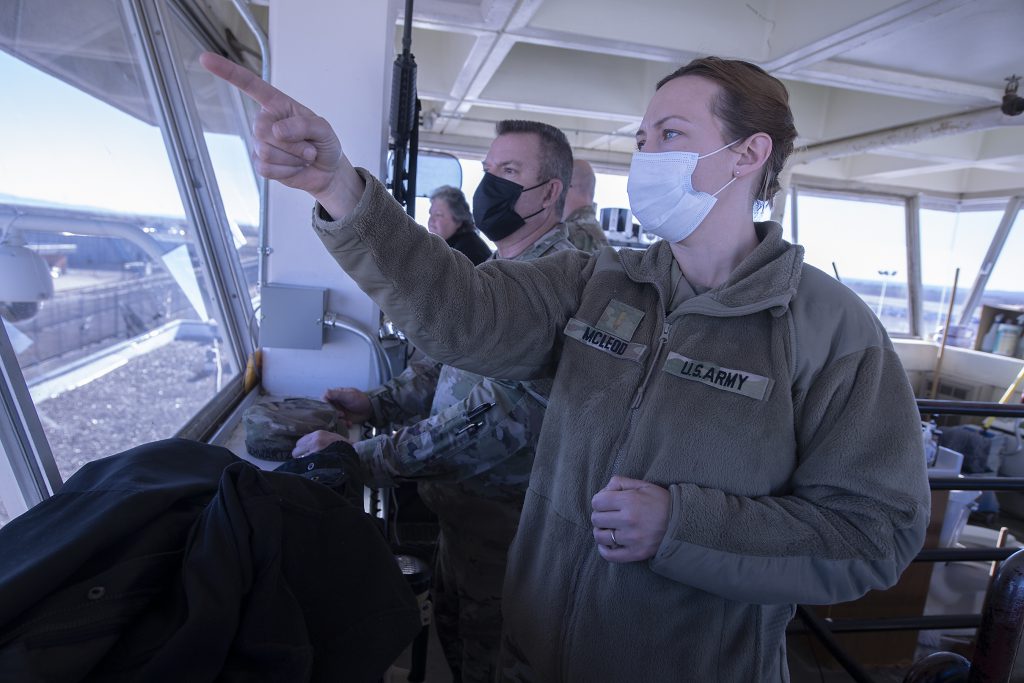
Maj. Robert Taylor/Idaho Military Division Public Affairs
Spc. Kyle Shuman grew up an Army brat and wanted to enlist into the Army himself. Five years ago, he enlisted into the Idaho Army National Guard as a 68W combat medic.
“I wanted to follow in my dad’s footsteps,” he said. “He used to say good things about the military. I thought that being in the National Guard would be a good way to serve in my community and still be in the military and have a civilian career.”
Shuman is one of approximately 75 Idaho National Guardsmen currently assisting the Idaho Department of Correction overcome staffing shortages due to the COVID-19 pandemic. Gov. Brad Little activated the Idaho National Guard for the fourth time Jan. 31, which also included support at multiple Primary Health Medical Group locations until Feb. 25.
Citizen-Soldiers and Airmen are performing non-security duties while the department is severely understaffed. He previously volunteered with the task force last year and deployed to Washington, D.C. in June 2020 to assist local civil authorities as part of an effort that included more than 5,000 National Guardsmen from 11 states and Washington D.C.
“I didn’t know what the mission would be,” he said. “I just volunteered to get new experiences and to get to do things I don’t get to do everyday and to meet people from other units.”
At the prison, Shuman said he assists with monitoring cameras in a control center and opens and closes doors as requested by correctional officers. Shuman said Guardsmen performing similar tasks throughout IDOC facilities helps free up correctional officers to perform security duties. The additional personnel allow residents to move around the facility as normal. Prior to the Idaho National Guard assistance, residents spent an increased amount of time in their cells throughout the day due to a lack of correctional officers.
“It makes me feel good to go out there and help the correctional officers with whatever they need help with,” said Sgt. 1st Class Vincent Mele, the non-commissioned officer in charge of the Idaho Guardsmen working at the state’s minimal security facility.
Mele is working at the facility’s front desk, where he helps sign visitors and staff in and out of the prison and answers the prison’s telephone.
“This mission provides a really good perspective on the world that maybe you didn’t have before hand,” he said. “We all get an idea of what the prison system might be like, and it’s definitely a little different in Idaho than I pictured.”
Guardsmen anticipate assisting IDOC until mid-March. Shuman, Mele and other Guardsmen will then return to their civilian jobs in their respective communities.
“We thank you for everything you’re doing for our staff and residents,” said Warden Timothy Richardson. “Before the Idaho National Guard arrived, at one point we were down to 48% staffing. We realize this is a unique and uncertain environment, but you’ve provided a solid cadre of troops and we couldn’t ask for a better group at such a critical time.”
Idaho deploys a small unit to the AFRICOM Area of Responsibility
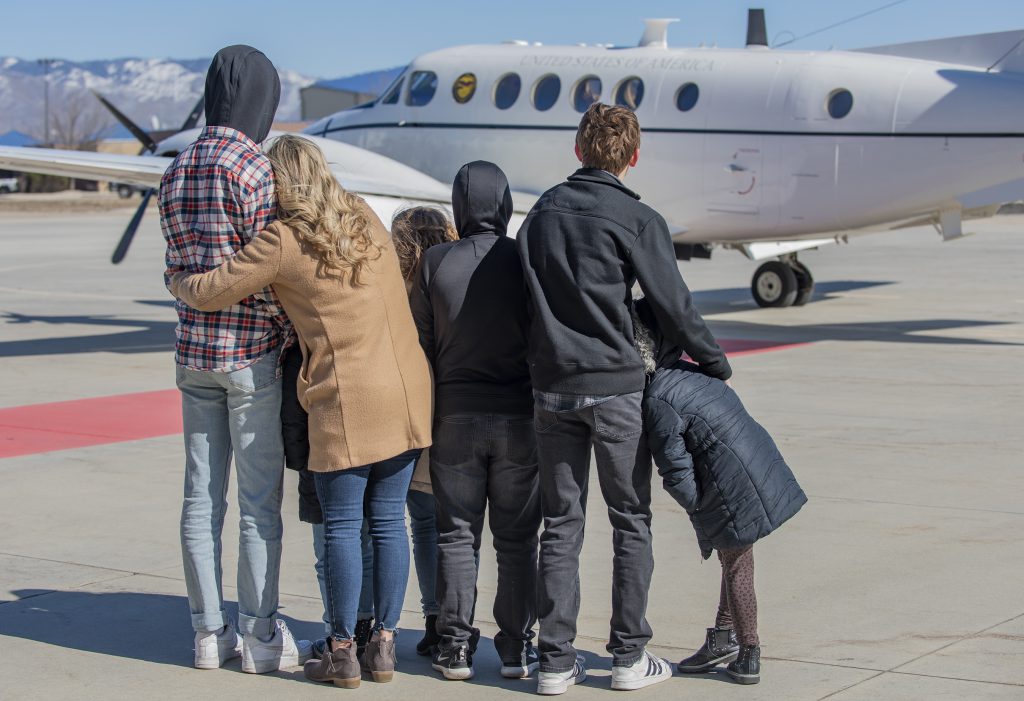
Master Sgt. Becky Vanshur/Idaho Military Division Public Affairs
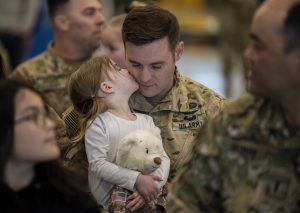 The Idaho Army National Guard Aviation Group deployed a small unit to the AFRICOM Area of Responsibility in support of Operation Enduring Freedom on Feb. 23, 2022. The unit will deploy for less than a year.
The Idaho Army National Guard Aviation Group deployed a small unit to the AFRICOM Area of Responsibility in support of Operation Enduring Freedom on Feb. 23, 2022. The unit will deploy for less than a year.
“The Idaho National Guard always answers the call when we are needed,” said Chief Warrant Officer 4 Spencer Widman, the unit’s commander. “The Africa mission is a noble example of this. I’m proud of the exemplary work the unit has accomplished when called upon in the past and I know their professionalism during this mission will fall in line with the Idaho National Guard’s high standards.”
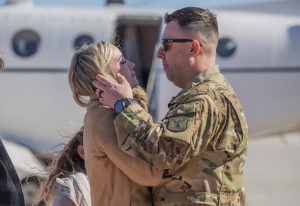 The small unit is based at Gowen Field and flies the C-12 Huron aircraft. This is a routine mission and the unit has supported several of these rotations in the past.
The small unit is based at Gowen Field and flies the C-12 Huron aircraft. This is a routine mission and the unit has supported several of these rotations in the past.
In 2010, the unit deployed to Afghanistan in support of Task Force Odin. They returned to Afghanistan in support of Task Force Caesar in 2013. In 2015, the unit deployed to Bogota, Columbia and to Kuwait in 2016 in support of Spartan Shield.
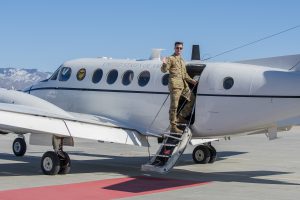 The C-12 Huron can readily accommodate cargo, passengers or both. It is also equipped to accept litter patients during medical evacuations missions. The first C-12 models entered service with the U.S. Army in 1974 and were used as a liaison and general personnel transport.
The C-12 Huron can readily accommodate cargo, passengers or both. It is also equipped to accept litter patients during medical evacuations missions. The first C-12 models entered service with the U.S. Army in 1974 and were used as a liaison and general personnel transport.
Daughter commissions into the Idaho Army National Guard as her father retires
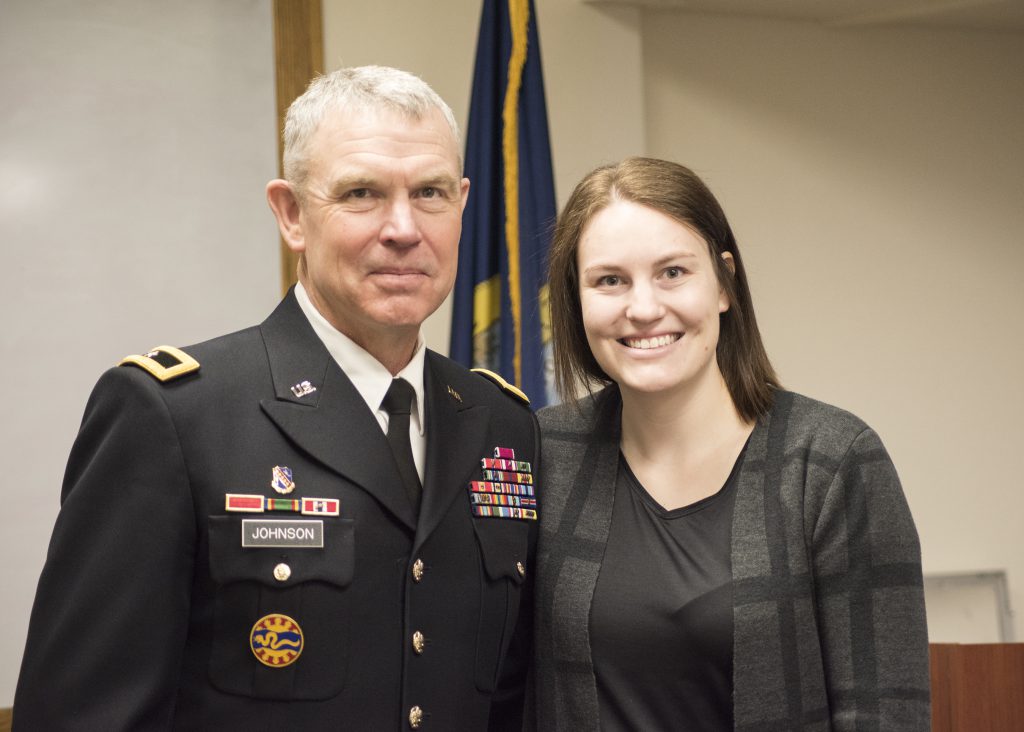
Maj. Robert Taylor/Idaho Military Division Public Affairs
2nd Lt. Marah Sharpe’s father has served in the Idaho Army National Guard for longer than she’s been alive. But despite commissioning into the organization Jan. 28, she will only have the opportunity to attend the same drill weekend with him once.
Her father, Brig. Gen. Russell Johnson, is set to retire in March after more than 41 years of service to the state and nation. Johnson, who currently serves as the Idaho National Guard’s director of the joint staff, first enlisted into the Idaho Army National Guard in November 1985. He served in the Marines from January 1981 to November 1985.
Sharpe direct commissioned as a 66H medical surgical nurse and will serve in the 116th Cavalry Brigade Combat Team, which Johnson commanded from February 2014 to March 2016.
“I don’t remember a part of my life that the Idaho Army National Guard wasn’t in,” Sharpe said. “My dad’s been in since I was born. The Guard has always been a part of my family and a part of my life growing up and I’m excited to be part of that organization myself.”
Sharpe said she previously considered joining the Idaho Army National Guard but the timing hadn’t been right. Now that she has completed her education and settled into her career as a nurse at Saint Alphonsus Regional Medical Center, she felt the timing was right.
Her ability to maintain her civilian career at Saint Alphonsus was important to her.
“I can stay in my civilian job that I really enjoy and be in the Guard at the same time,” she said. “It just seemed right.”
Sharpe said she became a nurse because she likes the flexibility the career offers, the science behind her job and the ability to help people. She is looking forward to practicing medicine in a uniform in addition to scrubs as she learns the demands of being a Soldier.
“I’m most excited to expand my knowledge as a nurse and as a person,” she said. “There’s a lot of learning opportunity for leadership as well as nursing. I’m excited to grow in both areas. I want to be a better nurse and be a better person.”
As a medical professional, Sharpe was able to earn a direct commission into the Idaho Army National Guard without having to complete basic training or a commissioning school. The Idaho Army National Guard accepts six to 10 such appointees each year, which include medical professionals, attorneys and chaplains.
“It’s always a proud moment when someone’s child goes in to the military,” Johnson said. “It shows a commitment to our state and nation with a level of enthusiasm and ambition that they share.”
“The Army and the National Guard are constantly changing,” said Johnson. “One thing that hasn’t changed is the importance of service to our country and state. Today’s Guard is in need of upcoming leaders and folks willing to step up and volunteer their time and efforts. It’s neat to see that level of commitment.”
Johnson administrated Sharpe’s commissioning oath Friday on Gowen Field.
“I’m very proud of her,” Johnson said.
Idaho National Guardsman develops wellness through Yoga

Crystal Farris/Idaho Military Division Public Affairs
After saying goodbye to her husband and kids, Master Sgt. Mary Ellen Reed heads to the gym early every morning for her daily workout. Working full-time for the Idaho Air National Guard and being a mother of two, Reed said it’s the only time in the day she has to herself to work on her physical and mental wellbeing.
“I go to bed excited to wake up the next morning and go to the gym,” said Reed. “It’s my favorite part of the day, beside maybe when I get home from work, but then the dog needs something from me or the kids are like “Mom, Mom,” and I’m on duty again, just in another capacity.”
One day a week she wakes up extra early on Thursdays to follow up her gym routine with a yoga session on Gowen Field where she works as a career manager for the 124th Fighter Wing.
The Idaho National Guard’s Service Member and Family Support program, with the help of two certified Yoga instructors who work for the organization, offer Warrior Yoga as one of its wellness opportunities for service members free of charge.
“We started offering the classes because yoga can help our service members develop a balance between mind, body and soul,” said Maj. Jennifer Pate, Idaho National Guard holistic health and fitness officer. “These are skills necessary to prevent harmful behaviors and to achieve true wellness.”
Although Reed had never practiced yoga, she is an avid weightlifter and has been training for body building competitions since 2018. She originally looked into practicing yoga to improve her mobility for competitive posing. Months after starting it, she realized its multifaceted benefits extended beyond just physical ones.
“While yoga has helped me improve my mobility tremendously, I feel it has become more of a mental benefit to me,” said Reed. “I still love the physical piece of it too, but what I really love is the quiet time it gives me to focus and the space it provides me to practice mindfulness, almost like meditation.”
Reed said her mental fitness is just as important to her as physical fitness and that developing mental wellness through yoga has enabled her to better cope in stressful situations, including when meeting the high demands of her job.
“I have a high demand job that I love, but if I didn’t take care of myself both mentally and physically, then I would have nothing to give in my job,” said Reed. “Yoga is a part of that wellness piece that helps me build myself up so I can successfully serve the members of my unit.”
Reed joined the Idaho Air National Guard in 2010, a year after she graduated from the College of Idaho. She originally enlisted into the organization’s cyber squadron and in 2014 began work full-time completing administrative tasks for the wing’s command support staff. As manager of a career field, she said her favorite part of the job is helping to develop those serving in that field.
After attending yoga one Thursday morning, Reed arrived to work where things were slightly more chaotic than usual. In that moment, Reed said she was able to respond better to the situation by applying some techniques learned through yoga.
“Yoga gives you that space to learn to pause and process how you’re going to receive information and then how you’re going to react to it,” said Reed. “It’s been helpful in stressful situations so that I’m not immediately overwhelmed and can handle things more effectively.”
Reed said she is thankful to continue serving in an organization that not only makes available to her free yoga classes and a fully equipped gym on base, but also an hour of paid time to work out every day.
“While fitness for me is personally very important, I love that the military also finds it important and that it gives you that time to work out during the duty day,” said Reed. “I used to work in banking before I was in the Guard full-time and know that very few civilian jobs give you that type of opportunity. The military is very supportive of your overall wellness and gives you the opportunities to improve that, which is one of the things I love most about being part of the military.”
The Idaho National Guard Service Member and Family Support program’s mission is to enhance the quality of life, strength, and resilience of its service members and their families. The program offers multiple resources including mental health counseling, financial advice, employment support, substance misuse assistance, Tricare assistance, youth programs and crisis management. For more information visit https://www.imd.idaho.gov/idaho-national-guard/family-programs/.
Warrior Yoga is offered every Tuesday and Thursday from 7-7:50 a.m. in Building 152 on Gowen Field.
Idaho Army National Guard completes UH-60M transition
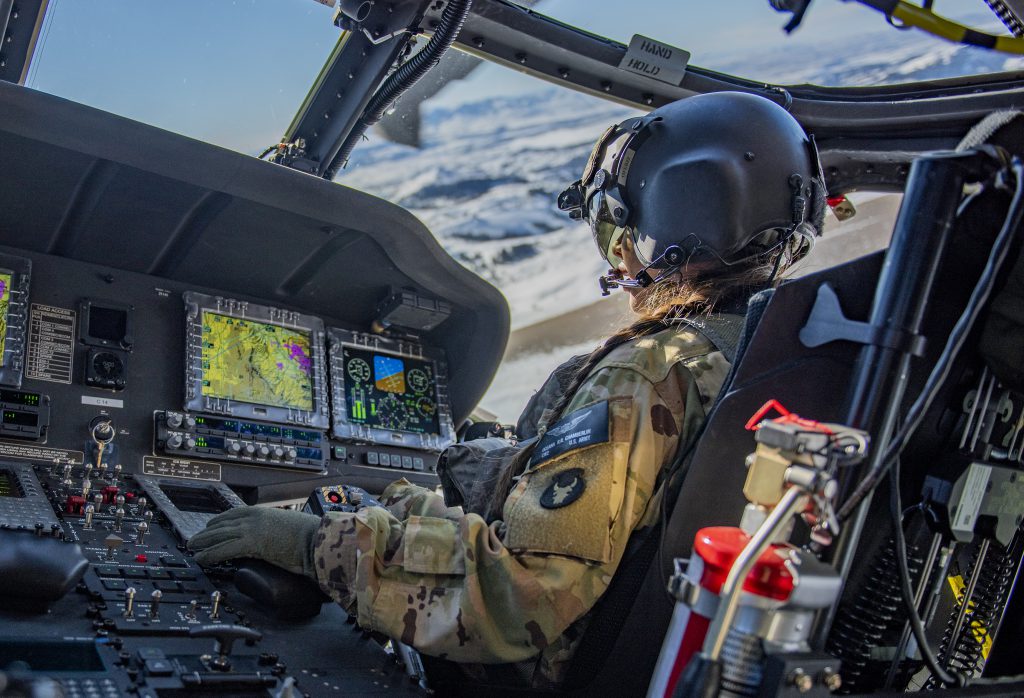
Maj. Robert Taylor/Idaho Military Division Public Affairs
With the arrival of its final two new UH-60M Black Hawks Sunday, the Idaho Army National Guard’s 1-183rd Assault Helicopter Battalion has completely modernize its previous fleet of A/L models to the Army’s most technologically advance multi-role helicopter.
“It’s a reflection of the quality and relevancy of the Idaho Army National Guard,” said Brig. Gen. Farin Schwartz, commander of the Idaho Army National Guard. “Combined with the 116th Cavalry Brigade Combat Team’s modernized armor equipment, the Idaho Army National Guard is one of the most modernized states in the Army National Guard. Modernized equipment enhances our capability to be interoperable with our active duty peers.”
The unit began transitioning to the new model in 2019 and is the fourth airframe unit pilots have flown since 2012. The UH-60M is an upgraded version of the legacy UH-60, designed to execute missions under all weather conditions. Its improvements allow commanders to move Soldiers and equipment faster on the battlespace and to mass effects across the full spectrum of conflict.
“It’s an exciting and unprecedented opportunity to have access to the newest air frame in the U.S. Army’s fleet,” said Lt. Col. Nicole Washington, 1-183rd AHB commander. “It’s exciting being on the leading and cutting edge of aviation. The M model has really set us up as a state and a National Guard entity to continue to lead the way and be on par with active duty counterparts.”
Improvements include a new airframe and propulsion system, more powerful engines and advanced digital avionics inside the cockpit. The glass cockpit is larger to give pilots more situational awareness of what is happening outside the aircraft and four multifunction display screens giving pilots access to multiple systems in real time.
Pilots can track their location on a moving map as well as friendly and enemy positions within the battlespace while communicating securely with other aircraft and ground personnel. Pilots can also map out an air route while in the cockpit to account for a change in mission mid-flight, Washington said.
Chief Warrant Officer 4 John Jacobs, a maintenance test pilot and maintenance test pilot evaluator, said the majority of the helicopter’s upgrades reduce pilot workload and fatigue.
The aircraft physically vibrates less, which Jacobs said makes pilots less tired after flying all day, and features an automated flight director system that functions similarly to a vehicle’s cruise control system. Jacobs said the equipment aids in low visual environments, such as dust and snow conditions, which improves the safety and efficiency of inserting ground forces on the battlefield.
“It’s easier to fly long days,” Jacobs said. “It’s amazing just feeling better when you get out of the cockpit. It’s the difference between driving 500 miles in a 1976 pickup truck versus a 2022 pickup truck.”
Jacobs said the helicopters’ stiffer blades handle sling loads better. The improved blades came in handy when the 1-183rd AHB participated in Idaho’s wildland firefighting efforts last summer. Crews dumped more than 200,000 gallons of water on multiple fires in northern Idaho using the new aircraft.
Pilots began attending a six-week transition course in 2019 to prepare for the new aircraft. The unit received its first UH-60M on Gowen Field in June 2020 and flew the remaining 19 airframes back from New Jersey to Boise over the past 18 months.
The 1-183rd AHB flew the AH-64A Apache for almost 20 years before transitioning to the AH-64D Longbow model in 2012 and then to the UH-60A/L Black Hawk through 2016-2018.
Washington said the multiple transitions caused pilots to go from gauges and dials in the legacy Apache to the technologically advanced Longbows, back to gauges and dials in the UH-60A/Ls before transitioning back to flying digitally. In addition, the transition to Black Hawks required the pilots to integrate crew chiefs into operations, something that wasn’t required in the Apache.
“Now we’ll work to become experts in this airframe, increase our competency and our ability to focus on air assault tasks and combat operations,” Washington said.
Idaho’s ESGR chair volunteers over 20 years
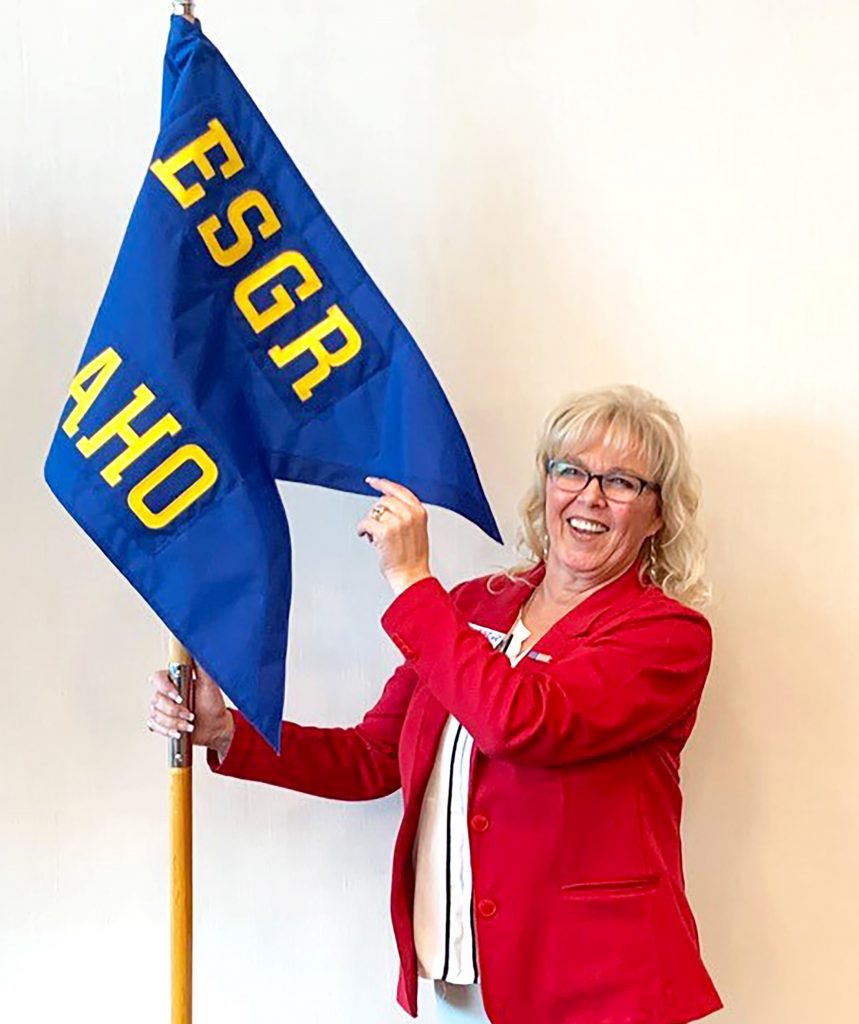
Before Cindy Reese joined the Employer Support of the Guard nearly 21 years ago, she participated in her first-ever employer outreach function, called a Bosslift, where she flew in a C130 to Fort Knox, Kentucky and visited with Soldiers.
She spent several days getting to know the Soldiers while living like one herself exploring tanks, eating in military dining facilities and shooting M16 rifles before returning to Idaho.
“After the other participants and I got off the plane and onto a bus, our event director asked us who had fun and was ready to go home,” said Reese. “Of course we all raised our hands. Then he asked us to take a moment and think of all those who didn’t get to come home from a deployment. There was not a dry eye on the bus. That’s when I decided I wanted to help make a difference and be part of something bigger than myself by joining the ESGR.”
Reese, who also works full time as a service manager for Tadd Jenkins Auto Group in Blackfoot, Idaho has since volunteered with the ESGR, helping to develop the program and relationships between Idaho National Guardsmen and their civilian employers.
She has held various positions including vice chair of the National Volunteer Support Subcommittee, which assists in the management, improvement and execution of ESGR volunteers, information technology and training programs.
Currently, she is serving her fifth year as the ESGR state chair of Idaho and in October, Reese was selected to serve as the National Volunteer Support Subcommittee chair.
For her service with the ESGR, Reese has received numerous awards including the Artillery Order of Molly Pitcher, the Seven Seals Award and the President’s Volunteer Service Award.
“ESGR is very near and dear to my heart,” said Reese. “The things our committee and I have been able to accomplish is because we have a great team, an incredible relationship with the military and we all have a true desire to be part of something more than ourselves. Many of our volunteers, like myself, did not serve in the military and this is our way to give back.”
About ESGR
ESGR is a Department of Defense program established in 1972 that promotes cooperation and understanding between reserve component service members and their civilian employers through outreach, recognition and educational opportunities.
The program operates through a network of more than 3,000 volunteers across 54 committees located in all 50 states, the District of Columbia, Guam, Puerto Rico and the U.S. Virgin Islands. Idaho’s ESGR Committee consists of more than 60 volunteers.
The Idaho National Guard helps to support ESGR and committee goals by promoting local employer outreach events such as Bosslift to build awareness of military missions while also recognizing civilian employers for their contributions and support to mission readiness.
Reese has contributed to more than two dozen state-wide and regional Bosslift events, in addition to other leadership and employer outreach events for organizations across the state, including chamber of commerce briefings.
Additionally, Reese has assisted the committee in recognizing hundreds of civilian employers throughout the state with various awards including the Secretary of Defense Employer Support Freedom Award, the Pro-Patria Award and the Above and Beyond Award.
“The support of our civilian employers is critical,” said Reese. “It’s been a real highlight of my career being able to recognize employers within our communities for that support by presenting them awards to let know how important they are to the success of our Guardsmen.”
In Feb. 2020, Idaho’s Adjutant General Maj. Gen. Michael Garshak, presented Reese and the Idaho ESGR committee, with their own guidon, recognizing the volunteers for their valuable contributions to the Idaho National Guard.
“Receiving the guidon meant a lot to us in the ESGR because it told us how important we are to the Idaho National Guard,” said Reese. “The ESGR would not be as successful as it is, if it were not for continued support of the Idaho Military Division leadership and the ESGR’s dedicated staff.”
“It’s always been about the people”
Reese had the opportunity to meet thousands of Guardsmen over the years, many who she now considers family. Much of the opportunities were life changing and strengthened her passion and commitment for volunteering, she said.
“They are the reason I volunteer,” said Reese. “It’s always been about the people. They are what keeps me going because I get to help make a difference in their lives and their families.”
In 2004, Reese visited Louisiana where thousands of Idaho Army National Guardsmen were conducting premobilization training prior to deploying. She served them Thanksgiving dinner and later shook their hands before they boarded a plane to Iraq.
“As I stood on the tarmac and shook hands with every single one of the thousands of Soldiers leaving, I remember seeing men and women, both young and old, with their backpacks and weapons,” said Reese. “Some had teddy bears and dolls given to them by loved ones. Some had tears in their eyes wondering if it was the last time they would see their families.”
Despite what those Soldiers left behind or sacrificed to deploy, Reese said their level of commitment to serve and do what they signed up for impressed her more than anything she had seen before. It was an once-in-a-lifetime opportunity that changed her, she added.
“The attitude and level of commitment those Soldiers portrayed that day changed the way I felt about the things I did in my own life,” said Reese. “It made me want to be more committed, dedicated and stand taller for the things I knew were right.”
In July 2019, Reese volunteered as chair of a committee that helped bring a replica of Washington D.C.’s Vietnam Veterans Memorial Wall to Blackfoot, Idaho. After the project completed two years later, “The Wall That Heals” opened for viewing during a ceremony in September 2021, where thousands of visitors attended.
Polish Land Forces attend Idaho National Guard tank training
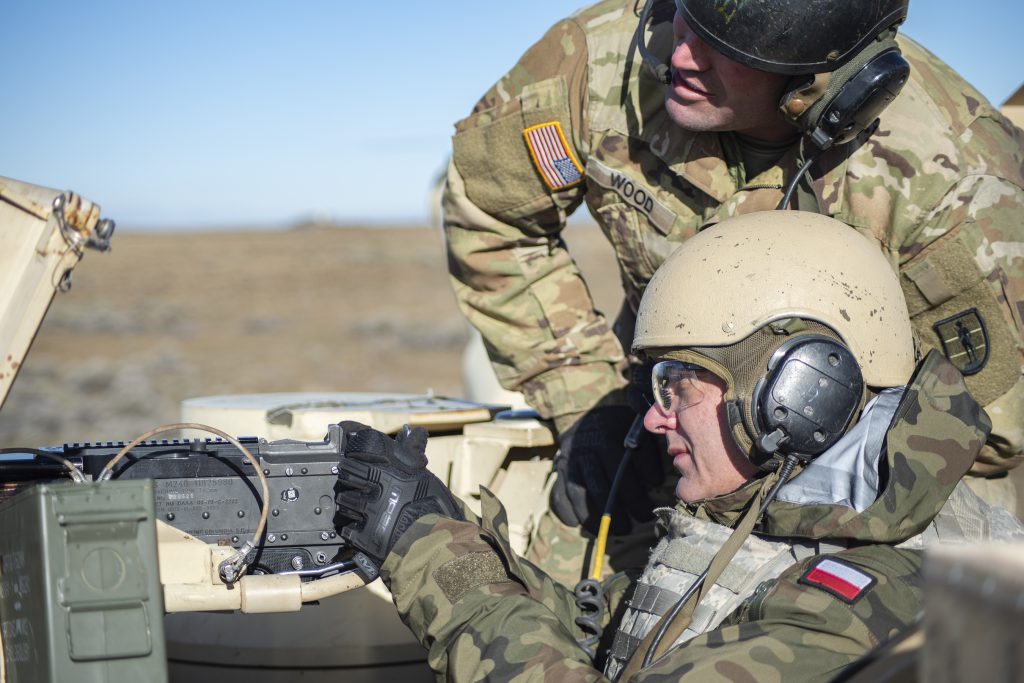
Crystal Farris/Idaho Military Division Public Affairs
Polish soldiers attended Idaho National Guard M1 Abrams tank training in October and November to share best practices on M1 Abrams training.
The Polish military—a U.S. ally, NATO member and official state partner of the Illinois National Guard—recently requested to purchase a fleet of M1A2 SEPv3 tanks and is working through the State Department and the Department of Defense to identify opportunities to partner in armor crew member training.
The Idaho Army National Guard’s 204th Regional Training Institute at Gowen Field trains U.S. military members in armor operation and tactics. During the visit, schoolhouse instructors and armor experts shared training and insights with the Polish.
“The 1st of the 204th Armored Training Battalion is the only National Guard battalion that teaches a full catalog of armored training courses,” said Maj. Noah Siple, commander. “We are credentialed to be the premiere armored training battalion of the National Guard. Couple that with our Orchard Combat Training Center and our ranges for armor-specific training, there is really no better place to go to.”
Polish officers and warrant officers serving in various positions including chief of planning and programming; logistician and fires experts; and company level officers, attended the battalion’s 19K transition course.
The battalion has provided armored training since the 1980s and offers various 19D and 19K courses, including a tank commander’s course and advanced leadership course. A portion of the curriculum requires students to train in the 143,000-acre OCTC, one of the country’s largest and most versatile maneuver training sites, located approximately 25 miles south of Boise.
Soldiers attending the course from the Idaho, Kansas, Oregon and Texas National Guards had the unique opportunity to interface with the Polish soldiers before graduating on Nov.22.
The 27-day course is designed for enlisted members in the ranks of sergeant and staff sergeant. The platoon-level coursework provides training in the technical and tactical skills necessary to employ the M1A1 or M1A2 SEP tank against enemy positions during unified land operations.
While Poland currently operates the T-72 and P-91 tanks, the M1A1 and M1A2 offers an array of operational differences and capabilities, said Sgt. 1st Class Lucas Kaserman, the 19K transition course manager.
“We integrated the Polish soldiers as much as possible into the training course to give them many of the same opportunities we give our U.S. students,” said Kaserman. “They already have a familiarity with tanks, which was helpful, however, the M1 is a different kind of tank with a lot of new things to learn.”
Throughout the course, Polish members took turns rotating through the driver, loader, gunner and commander crew stations; participated in tank simulators where they operated as both tank commander and gunner while engaging simulated targets; and conducted live-fire familiarization in the OCTC, where they fired different weapon systems of the tank, including an M240 and .50 caliber machine gun.
Additionally, they spent time with course experts and senior leaders of the Idaho Army National Guard, including its 116th Cavalry Brigade Combat Team, an M1 tank unit.
“They came here to experience first-hand training with the M1A2V2 Abrams tank and to understand how we train and construct courses for Soldiers becoming tankers in the U.S. military,” said Siple. “They also got to engage and build relationships with all elements of the Idaho Army National Guard.”
In November, senior leaders from the Polish Land Forces and Illinois National Guard visited Idaho to observe course training and what the 1-204th RTI has to offer. The visitors had the opportunity to tour some of the Idaho Army National Guard’s facilities, equipment and its premiere OCTC, in addition to engaging with Idaho’s leadership and armor experts.
The Illinois National Guard and Republic of Poland enjoy an enduring State Partnership Program focused on professional military education, crisis management and response as well as operational combat and deployment training. The partnership began in 1993 just after Poland emerged from behind the USSR’s Iron Curtain. Poland was accepted as a full NATO ally in 1999. Polish and Illinois National Guard soldiers co-deployed first to Iraq and then to Afghanistan from 2003 to 2020.
The Illinois National Guard does not operate or maintain the M1 tank and helped facilitate the co-training with Idaho.
The Nez Perce Tribe and Idaho National Guard work together during COVID-19
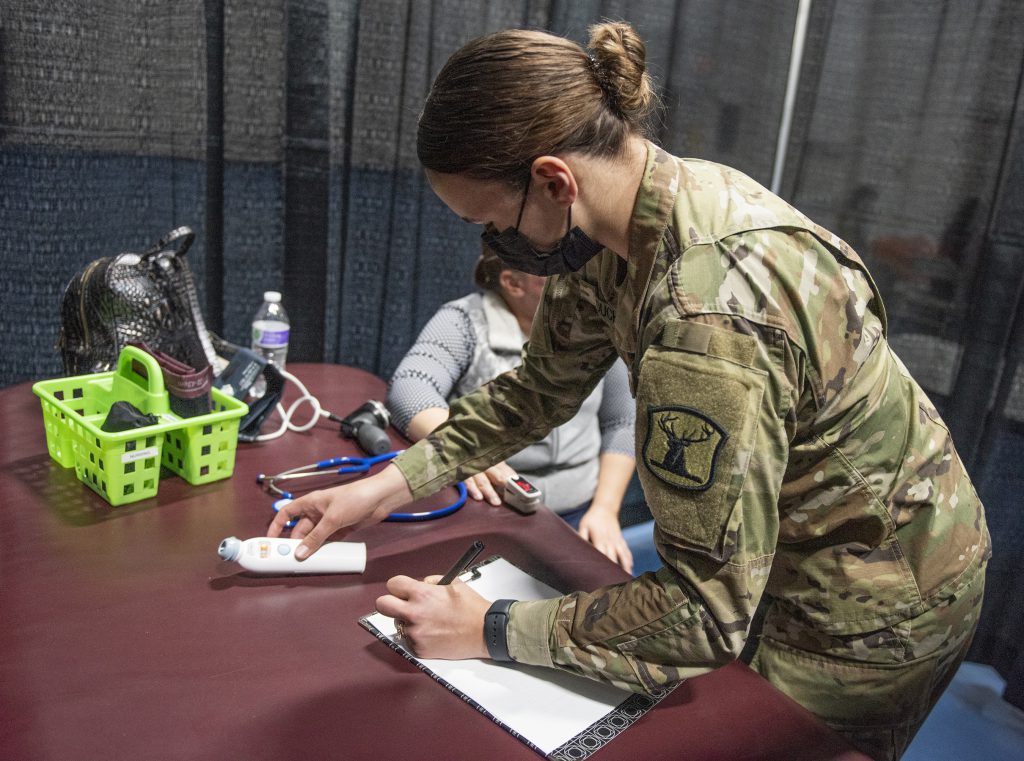
Master Sgt. Becky Vanshur/Idaho Military Division Public Affairs
Nez Perce Reservation, IDAHO – Idaho National Guard and Nez Perce dental personnel teamed up Nov. 10 – 13 as part of a larger effort to recover from the summer’s surge of COVID-19 cases plaguing northern Idaho.
The Nez Perce Tribe and the Idaho National Guard are working together through a program known as Innovative Readiness Training to help the Nez Perce community’s healthcare system recover after becoming backlogged during a community-wide shut down earlier this year. The dental visit was part of a larger medical effort taking place between the tribe and the Idaho National Guard.
“Idaho National Guard members are driven by a sense of purpose,” said Maj. Gen. Michael Garshak, the adjutant general of Idaho. “IRT collaboration like this not only enables us to sharpen our military skills, but it also provides great opportunities to make positive impacts to the communities of Idaho and a difference in the lives of our fellow citizens.”
The Nez Perce tribe submitted a collaborative IRT application earlier this summer to request assistance in addressing their overwhelmed medical staff resulting from the second wave of COVID-19 cases. The Idaho National Guard responded by sending medical and dental citizen-Soldiers and Airmen performing three missions—a two-part diabetic IRT in June and October, a medical IRT in August and most recently the dental IRT in November, which resulted in dental screenings of nearly 250 Nez Perce school-aged children. Activities also included helping local clinics complete high school sports physicals and preschool Head Start program physical exams before the start of sports season and the school year.
“Working with their local health care personnel helps us build relationships with the tribes while training our Idaho National Guard medical personnel,” said Lt. Col. Tina Williams, an occupational health nurse for the Idaho Army National Guard. “Our mission is to help the Nez Perce community catch up on a backlog of patients while providing Guardsmen relevant training and a unique experience by seeing both adults and children at the Nez Perce clinics.”
Idaho National Guard personnel also assisted tribe clinicians at two large COVID-19 vaccination clinics located at Lapwai and Kamiah.
“The National Guard has helped us with several projects throughout the pandemic,” said Roxie Kim Hartwig, M.D. at Nimiipuu Health with the Nez Perce Tribe. “One of our mass vaccination events would have been impossible without the Idaho National Guard. The purpose of the diabetic IRT is to help us catch up with care that has been delayed due to the pandemic and provides training for the National Guard medical staff to gain some practical knowledge about our medical application.”
Williams said the Nez Perce staff was thankful for the Idaho National Guard’s timely assistance with the diabetic clinics, sports physicals and dental exams as the tribe is beginning to see another increase in COVID-19 screenings.
Idaho Army National Guard deploys to Southwest Asia
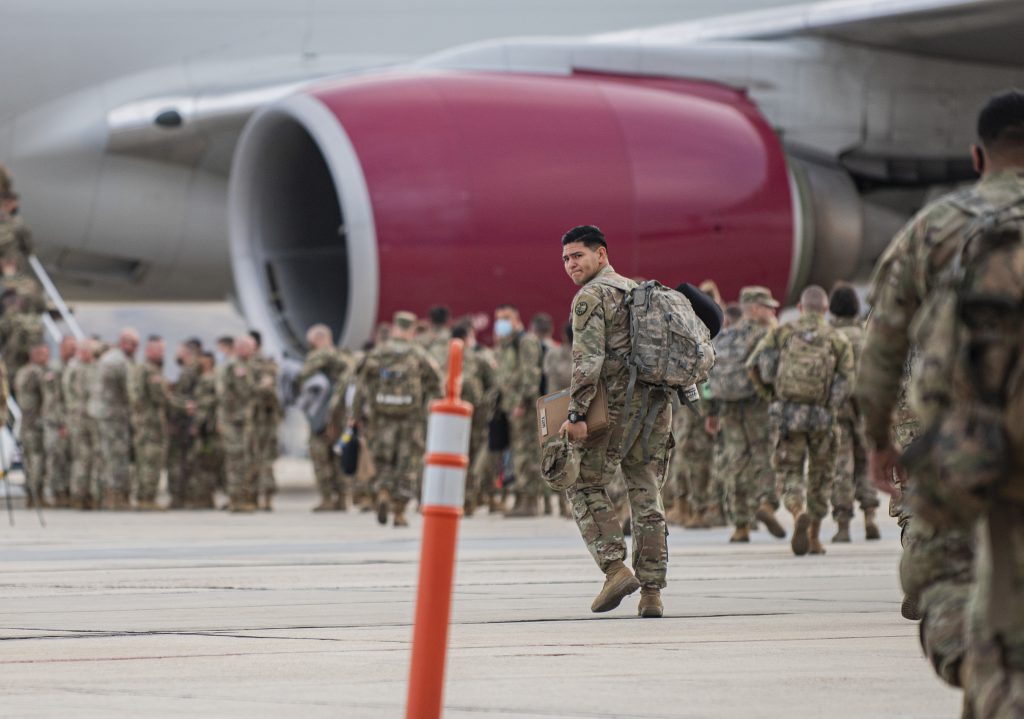
More than 250 Soldiers from the Idaho National Guard’s largest unit, the 116th Cavalry Brigade Combat Team, left for a 12-month deployment on Nov. 5 to Southwest Asia in support of Operation Spartan Shield. The brigade has trained for more than a year in anticipation of this mobilization.
OSS is a joint mission under the United States Central Command and is part of Operation Enduring Freedom. Idaho Soldiers will comprise nearly 20 percent of the 116th CBCT task force during this rotation. Soldiers from 116th CBCT units in Montana, Nevada and Oregon, as well as the Florida Army National Guard, will also fall under the task force.
“The Soldiers of the 116th are trained and ready to go,” said Lt. Col. Eric Orcutt, 116th CBCT commander. “I could not be more proud of these men and women and the efforts they’ve put forth in training and preparing for this mission. They are eager and they are focused and as always, they will achieve the highest level of success.”
OSS is an ongoing operation and supported primarily by Army National Guard units from across the country. This deployment is anticipated to last approximately 12 months and is the first rotation the brigade is scheduled to support, with the second rotation occurring in the summer of 2022. The Soldiers mobilizing today will receive 45 days of additional training stateside before deploying overseas.
The 116th Cavalry Brigade Combat Team previously deployed in support of the Global War on Terror in 2004 and 2010 to Iraq. Additionally, more than 400 Idaho Air National Guardsmen deployed to Southwest Asia in the summer of 2020.
COVID response prompts Idaho National Guard to establish first dual-status commander
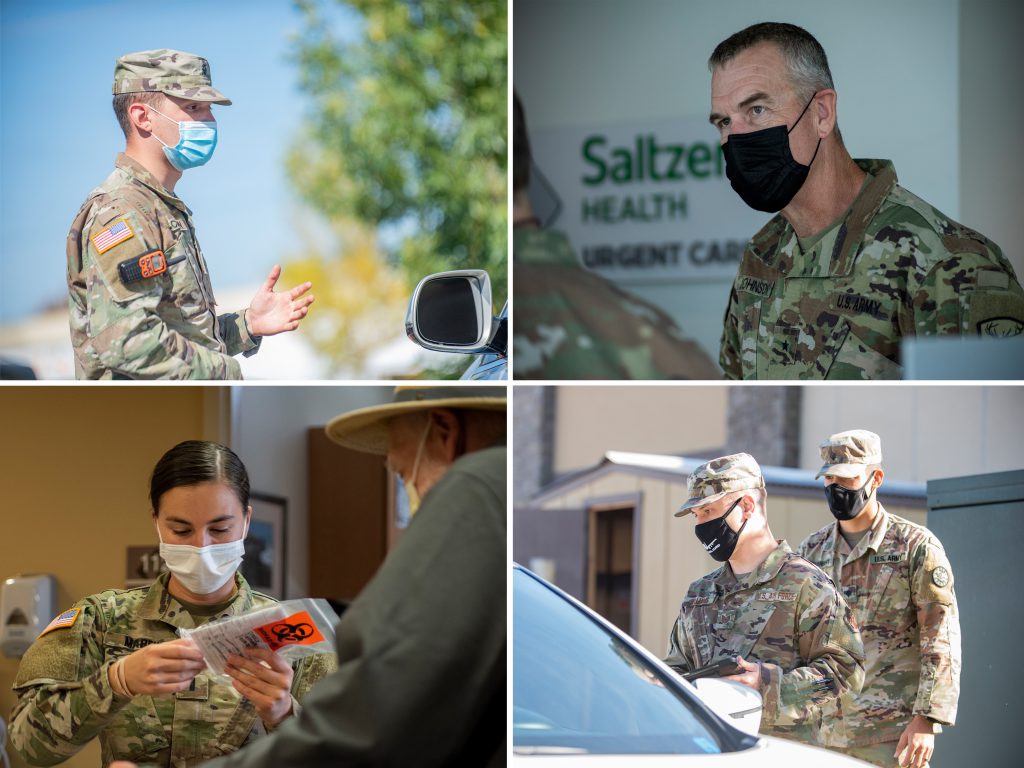
Idaho Military Division Public Affairs/Crystal Farris
In September, after a second wave of COVID-19 cases spread across Idaho, Gov. Brad Little authorized the mobilization of up to 150 Idaho National Guard Soldiers and Airmen. He also requested additional federal support as a last-ditch effort to avoid activating a statewide crisis standards of care—a first in Idaho’s history.
On Sept. 7, at the recommendation of Gov. Little and the Adjutant General of Idaho Maj. Gen. Michael Garshak, U.S. Northern Command appointed Brig. Gen. Russ Johnson, Idaho National Guard director of joint staff, as the state’s first-ever dual-status commander. That same day, Idaho Guardsmen and federal active duty military personnel began reporting to hospitals, clinics and other medical facilities across the state in support of overwhelmed medical staff.
“Joint Task Force – Idaho is helping free up civilian medical staff allowing them to focus on providing medical care during the ongoing surge in COVID-19 cases,” said Johnson. “Collectively, our Title 32 Idaho National Guardsmen and Title 10 active duty personnel are employed in direct support of our healthcare sector, making a difference in the lives of Idaho citizens every day.”
Currently, Idaho National Guardsmen are serving at nearly two-dozen healthcare facilities across the state performing non-clinical duties including medical screenings, testing collection, logistics assistance and other administrative tasks.
Idaho National Guard Col. Britt Vanshur, chief of the joint staff, said the Idaho National Guard provides support in administrative functions rather than playing a clinical role, since the majority of its medical professionals are part-time Guardsmen already working full time at hospitals, clinics and healthcare facilities.
“It would be imprudent to pull our Idaho Guard medical personnel from their civilian capacities at these healthcare facilities just to activate and send them back in uniform to perform these same tasks,” said Vanshur. “They’re already making a positive impact on the health districts in their civilian capacity.”
This activation marks the second time since the beginning of the pandemic that Idaho National Guardsmen have deployed in response to COVID-19. In March 2020, the Idaho National Guard began mobilizing more than 400 citizen-Soldiers and Airmen as part of the organization’s first COVID-19 relief effort, named Task Force Agile Response.
During this second wave, while record numbers of COVID-19 cases overwhelmed northern Idaho, Kootenai Health requested assistance through the Idaho Office of Emergency Management as the hospital’s capability reached its limits, forcing it to implement emergency standards of care.
In response to this request, the Department of Defense, through U.S. Northern Command, allocated a U.S. Army medical response team. The 23-person MRT is augmenting Kootenai Health by providing doctors, nurses and respiratory therapists from various commands and locations, including Fort Carson, Colorado and Joint Base Lewis-McChord, Washington.
This is the first time in Idaho history that Title 32 and Title 10 personnel have mobilized under one joint task force creating the demand for a dual-status commander to effectively coordinate response efforts between both forces.
“Dual-status command effectively streamlines National Guard and active component efforts under a single commander in support of state and federal civil authorities,” said Johnson. “It ensures we all pull in the same direction to meet the needs—current and emerging—of the governor and his emergency management leadership.”
Idaho is one of several states to recently activate a dual-status commander for COVID-19 response. Other states include Alabama, Mississippi, Louisiana and Tennessee.
Members of Joint Task Force – Idaho have collectively worked thousands of hours since September, while providing care to COVID-19 patients and much-needed relief to overworked healthcare facility staffs.
“Idaho’s joint task force has been highly successful on many fronts,” said Johnson. “Our Guardsmen and active duty counterparts have put their personal lives on hold to come together and answer the call of fellow citizens during this historic pandemic.”
 Official Government Website
Official Government Website